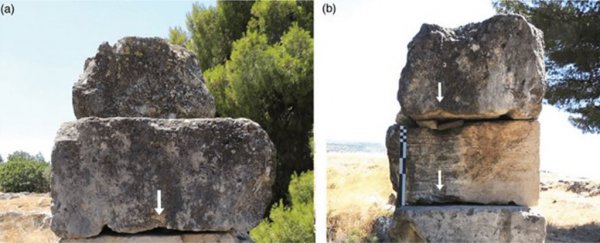Fundamentally, the cranes that dot city skylines today aren't hugely different from the ones that the Greeks invented sometime around the late sixth century BCE – a remarkable effort of engineering. But new research argues that the Greeks may have used a clever lifting mechanism more than a century before they even invented cranes.
There's some debate over how the Greeks constructed their huge stone buildings before the crane arrived on the scene, and when lifting mechanisms might have started to overtake the traditional use of ramps to get huge stones in place.
Architectural historian Alessandro Pierattini, from the University of Notre Dame in Indiana has now presented a new analysis of stone from the earliest Greek temples. He claims that blocks were being lifted and dropped into position around 150 years before the crane.
 Some of the stone blocks studied. (Pierattini, Annual of the British School at Athens, 2019)
Some of the stone blocks studied. (Pierattini, Annual of the British School at Athens, 2019)
"The foremost discovery of the Greeks in building technology is the crane," says Pierattini. "No previous civilisations are known to have used it, and it has remained central to building construction without remarkable changes for nearly 25 centuries – because it was perfect."
Central to Pierattini's study are the rope grooves found in blocks from the period, used in temples including those at Isthmia and Corinth. There's been some debate over whether ropes were used to lift blocks into their final resting place, or to pull them out of the quarry – and Pierattini says the former is most likely.
By analysing the grooves on ancient stones and running experiments with ropes made as they would've been made at this point in history, Pierattini put forward a new hypothesis on the logistics of construction, coming to the conclusion that a rope lifting system would be enough to raise these 200-400 kilogram (441-882 pound) blocks.
Pierattini also found evidence of blocks moved from a quarry site without any grooves having been added, further backing up the hypothesis that the grooves weren't needed until it was time to put the stones in place.
On top of that, the researcher noted other cuttings and grooves in several stone blocks that suggested the blocks were rolled into place after being lifted, using a clever combination of levers and rollers that laid the basis for more sophisticated techniques.
 How the lifting might have worked. (Alessandro Pierattini)
How the lifting might have worked. (Alessandro Pierattini)
"While examining the blocks, I found evidence that after being lifted, the blocks were manoeuvred into place with a method anticipating the Classical period's sophisticated lever technique," says Pierattini.
"The placement involved a combination of levers and ropes that allowed for lowering each block tight up against its neighbour already in place in the wall. This is the earliest documented use of the lever in Greek construction in historical times."
Pierattini suggests this pushes back the use of lifting machines earlier than was previously thought, by about a century and a half. The use of proper cranes however – with winches and hoists – didn't come until later, as previous research has already indicated.
It's a fascinating piece of research that suggests Ancient Greek construction methods were even more innovative than we suspected. Their structures may have been constructed thousands of years ago, but it's fun to think that with a bit of detective work, we can trace back the techniques that were used.
"Study of groove depth, maximum block weight and rope strength shows that the original thesis that the grooves were used in lifting is technically plausible," concludes Pierattini in his published paper.
"Moreover, this thesis seems more compelling in explaining the grooves' peculiar dispositions than the alternative theory that they were used in quarrying."
The research has been published in the Annual of the British School at Athens.
